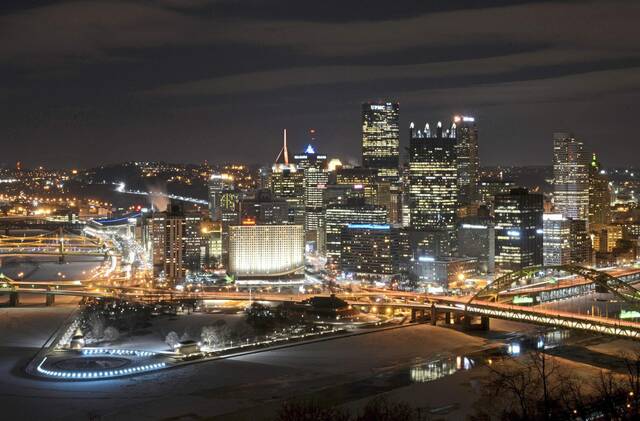Migratory birds being helped on journey by Pittsburgh Lights Out program
As the calendar flips to fall, roughly a hundred thousand birds are passing over the Pittsburgh region as part of their seasonal migration.
It’s not an easy trip and apparently the bright artificial light given off by the tall buildings that make up the city’s skyline isn’t helping.
Migrating birds can cover thousands of miles. While their navigational skills aren’t completely understood, the birds’ GPS is generally provided by the sun, the stars, and by sensing the earth’s magnetic field. But for long-distance migrants, all that can be thrown off by communication towers and tall buildings.
Now Pittsburgh is joining a national movement — the Lights Out initiative — that is convincing building owners and tenants to turn off as much inside and outside building light as possible at night, especially on upper floors.
Many species of birds are attracted to the lights of tall buildings. Millions are killed each year in collisions with those cement and steel edifices.
“The National Aviary is thrilled by the enthusiastic support of the Downtown business community for this important initiative that will make the night skies safer for birds as they journey over our city,” said Robert Mulvihill, National Aviary ornithologist.
A group of organizations including the Building Owners and Managers Association of Pittsburgh, BNY Mellon, Birdsafe Pittsburgh, Carnegie Museum of Natural History, Pittsburgh Downtown Partnership and the National Aviary are working together to dramatically lower the number of bird window collisions and disorientation of birds caused by bright artificial light in the city at night.
In turn, these organizations and businesses are asking people to pledge to turn off unnecessary lights from midnight to 6 a.m.
“One of the problems is that (birds) waste energy simply by coming to the lights and may even divert off their migratory path,” said Mulvihill. “The 9/11 tribute lights (in New York) have shown, using radar, that the thousands of birds that swirl around in those lights have come from (up to) 100 or more miles away, that they’ve deviated from their path to reach that light.”
Mulvihill cites a Cornell University Lab of Ornithology study showing nearly 3 billion breeding adult birds have been lost in the last half-century because of bright artificial light in cities.
“This is by no means a new thing. What is new is the scale of the artificial lights at night,” said Mulvihill. “It’s only because that problem has been able to influence the migratory paths and the migration success of so many birds that we’re finally beginning to sort of open up our own eyes to the fact there may be a problem.”
Volunteers with BirdSafe Pittsburgh have been conducting monitoring in the Downtown area during migration seasons, collecting data to document bird fatalities, and to provide care for birds with injuries sustained from window collisions.
“This exciting initiative will further the research of BirdSafe Pittsburgh, and save numerous migrating birds as they make their journey south for the fall and winter months,” said Jonathan Rice, urban bird conservation coordinator for BirdSafe and Carnegie Museum of Natural History.
Birdsafe will document the progress made on reducing bird mortality resulting from the Lights Out initiative.
Remove the ads from your TribLIVE reading experience but still support the journalists who create the content with TribLIVE Ad-Free.

